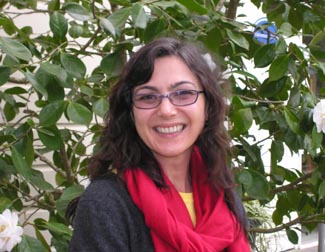"Sevdah" is a Serbian musical tradition and emotion about the pain that results from separation of love.
"In the Balkans," says Nada Miljkovic, a 43-year-old graduate student in the UCSC Digital Arts and New Media program (DANM), "sevdah is a tradition sung by those forced into marriage in an extremely patriarchal society, a culture that objectifies women as a commodity."
Miljkovic knows a lot about forced marriages. In fact, she's a child of one.
That experience has led to a thesis project titled "Balkan Song," a multi-channel video installation, performance piece, and social networking site that will be featured at the Santa Cruz Museum of Art and History, beginning on May 29 and running through June 24.
Her project is one of several student works that will be presented during the second phase of the UCSC DANM program's "InterACTIVATE" exhibition.
Miljkovic's installation includes a remarkable short film, Eva on Marriage, in which her 10-year-old daughter muses about the idea of marriage. The film recently screened at the 2009 Santa Cruz Film Festival.
Her exhibit also includes videos depicting forced marriage from the point of view of her father ("It was my choice, I don't look back"), her mother ("I was in love with another man, but forced to marry"), and herself ("I grew up thinking subconsciously that marriage is when a man buys a woman.")
Miljkovic made her first film in 2007, a feature length work called Two Villages One Heart, about how the town of Ben Lomond--where she now lives in the Santa Cruz mountains--is similar to her ancestral village in Serbia. The film was inspired by her reaction to the media's portrayal of life in Yugoslavia during the recent Balkan conflict.
"After the bombing in Yugoslavia where my family was living, I wanted to do something to counter the media demonizing part of my identity," says Miljkovic. "I made the film as a way of showing my friends here what my relatives were like in Yugoslavia, and showing my relatives what my family was like here. They have a great deal in common."
Born in Belgrade, Miljkovic moved to the Chicago area to attend Purdue University, where she a earned a B.S. in construction management and a B.A. in philosophy. After graduation, she moved to California and worked as highway inspector for Caltrans and also for the Bay Area's BART Extension program.
In 1995, Miljkovic moved to Ben Lomond and began working locally as a civil engineer. She applied to UCSC's new graduate program in digital arts and new media after an inspiring conversation with DANM program manager Felicia Rice.
"Computer science, film and digital media, art, philosophy.when I met with Felicia and she explained what the program was all about, I thought it was so like me!" recalls Miljkovic.
"DANM is a very ambitious program; it's been a very intense two years," she adds. "They are pushing us to articulate the very newest contemporary art theory, and showing us how to describe our work and write about it. They're teaching us how to do what it takes to be an artist in today's art world-how to put on an exhibition, to curate, and to do public relations."
Miljkovic says she loves to experiment using different forms of digital media, and she is particularly interested in seeing the effect of art on web sites.
"The whole idea that art can be a dialogue was something I felt intuitively, but didn't have a handle on until now," Miljkovic notes. "It's about having the opportunity to change someone's mind--and affect them emotionally--in hopefully a better way."
Nada Miljkovic will perform a three-hour "Balkan Song" vocal performance piece to open the exhibit on Friday, May 29, from 1 to 4 p.m. An opening reception for the exhibition will also be held on June 5, from 6:30 to 8:30 p.m. Both events are free and open to the public. The exhibition runs until June 24. For more information, call the Museum of Art & History at (831) 429-1964 or go to the UCSC DANM web site at: http://danm.ucsc.edu.




